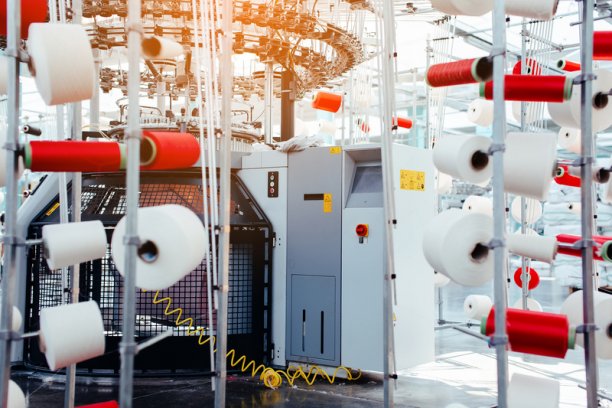
Surge in global textile machinery shipments
Overall worldwide shipments of new textile machinery decreased in 2020.

10th June 2021
Knitting Industry
|
Zurich, Switzerland
The International Textile Manufacturers Federation (ITMF) has published its 43rd annual International Textile Machinery Shipment Statistics (ITMSS) for 2020, which was compiled in cooperation with more than 200 textile machinery manufacturers representing a comprehensive measure of world production. The report covers six segments of textile machinery, namely spinning, draw-texturing, weaving, large circular knitting, flat knitting and finishing.
In 2020, global shipments of spinning, texturing, weaving, knitting, and finishing machines decreased on average compared to 2019. However, shipments of large diameter circular knitting machines bucked the trend increasing compared to the previous year.
Deliveries of new short-staple spindles, open-end rotors, and long-staple spindles dropped by 48%, 27%, and 46%, respectively. The number of shipped draw-texturing spindles declined by 30% and deliveries of shuttle-less looms shrunk by 16%. Shipments of flat knitting machines contracted by 53%, while shipped large diameter circular machines marked the exception with a 13% growth. The sum of all deliveries in the finishing segment also dropped by 17% on average.
Knitting machinery
Global shipments of large circular knitting machines grew by 13% to 30,231 units in 2020. The Asia & Oceania region was the world’s leading investor in this category with 81% of worldwide shipments. With 62% of all deliveries (15,980 units), China was the favoured destination. India and Turkey ranked second and third with 2433 and 2381 units, respectively.
In 2020, electronic flat knitting machine segment decreased by 52% to around 66,000 machines. Asia & Oceania was the main destination for these machines with a share of 77% of world shipments. China remained the world’s largest investor with an 38% share of total shipments despite a 74% decrease in investments. Shipments to China dropped from about 69,000 units in 2019 to 17,000 units in 2020.
Spinning machinery
The total number of shipped short-staple spindles decreased by about 3.3 million units in 2020 to a level of 3.63 million. Most of the new short-staple spindles (88%) were shipped to Asia & Oceania, where delivery decreased by 50%. While levels stayed relatively low, Europe saw shipments increasing by 76% (mainly in Turkey). The six largest investors in the short-staple segment were China, India, Turkey, Pakistan, Bangladesh, and Uzbekistan.
422 thousand open-end rotors were shipped worldwide in 2020. This represents 151 thousand units fewer compared to 2019. 83% of global shipments went to Asia & Oceania where deliveries decreased by 32% to 351 thousand rotors. Turkey, and Pakistan were the world’s 2nd and 3rd largest investors in open-end rotors after China and saw investments surging by 290% and 42%, respectively. China, India, Uzbekistan, and Brazil, the world’s 1st, and 4th to 6th largest investors in 2020 reduced investment by 30% on average.
Global shipments of long-staple (wool) spindles decreased from about 40,000 in 2019 to nearly 22,000 in 2020 (down 46%). This effect was mainly driven by a fall in deliveries to Asia & Oceania with a decrease in investment of 75%. 80% of total deliveries were shipped to Iran, Turkey, and Italy.
Texturing machinery
Global shipments of single heater draw-texturing spindles (mainly used for polyamide filaments) decreased by 36% from nearly 26,000 units in 2019 to 16,000 in 2020. With a share of 89%, Asia & Oceania was the strongest destination for single heater draw-texturing spindles. China, Japan, and Chinese Taipei were the main investors in this segment with a share of 63%, 9%, and 8% of global deliveries, respectively.
In the category of double heater draw-texturing spindles (mainly used for polyester filaments) global shipments decreased by 30% to a level of 325,000 spindles. Asia’s share of worldwide shipments remained stable at 90%. Thereby, China remained the largest investor accounting for 78% of global shipments.
Weaving machinery
In 2020, worldwide shipments of shuttle-less looms decreased by 16% to 112,000 units. Shipments in the categories, air-jet and rapier and projectile fell by 3% to 29’337 units and -15% to 21,542, respectively. Deliveries of water-jet looms decreased by 21% to 61,483. The main destination for shuttle-less looms in 2020 was Asia & Oceania with 94% of all worldwide deliveries. 98%, 93%, 81% of global waterjet, air-jet, and rapier/projectile looms were shipped to the same region. The main investor was China in all three sub-categories. Deliveries of weaving machines to the country amount to 74% of total deliveries.
Finishing machinery
In the ’fabrics continuous’ segment, shipments of Sanforizers / Compacters grew by +75%. All other subsegments either remained stable or shrunk. Since 2019, the ITMF estimates the number of shipped stenters non-reported by the survey participants to inform on the global market size for that category. The market for stenters is expected to have been stable since 2019 and thus deliveries may have reached 1731 units in 2020.
In the ‘fabrics discontinuous’ segment, the number of jigger dyeing / beam dyeing machines shipped dropped by 8.5% to 529 units. Deliveries in air jet dyeing and overflow dyeing categories decreased by 18% and 21% respectively in 2020.

Business intelligence for the fibre, textiles and apparel industries: technologies, innovations, markets, investments, trade policy, sourcing, strategy...
Find out more